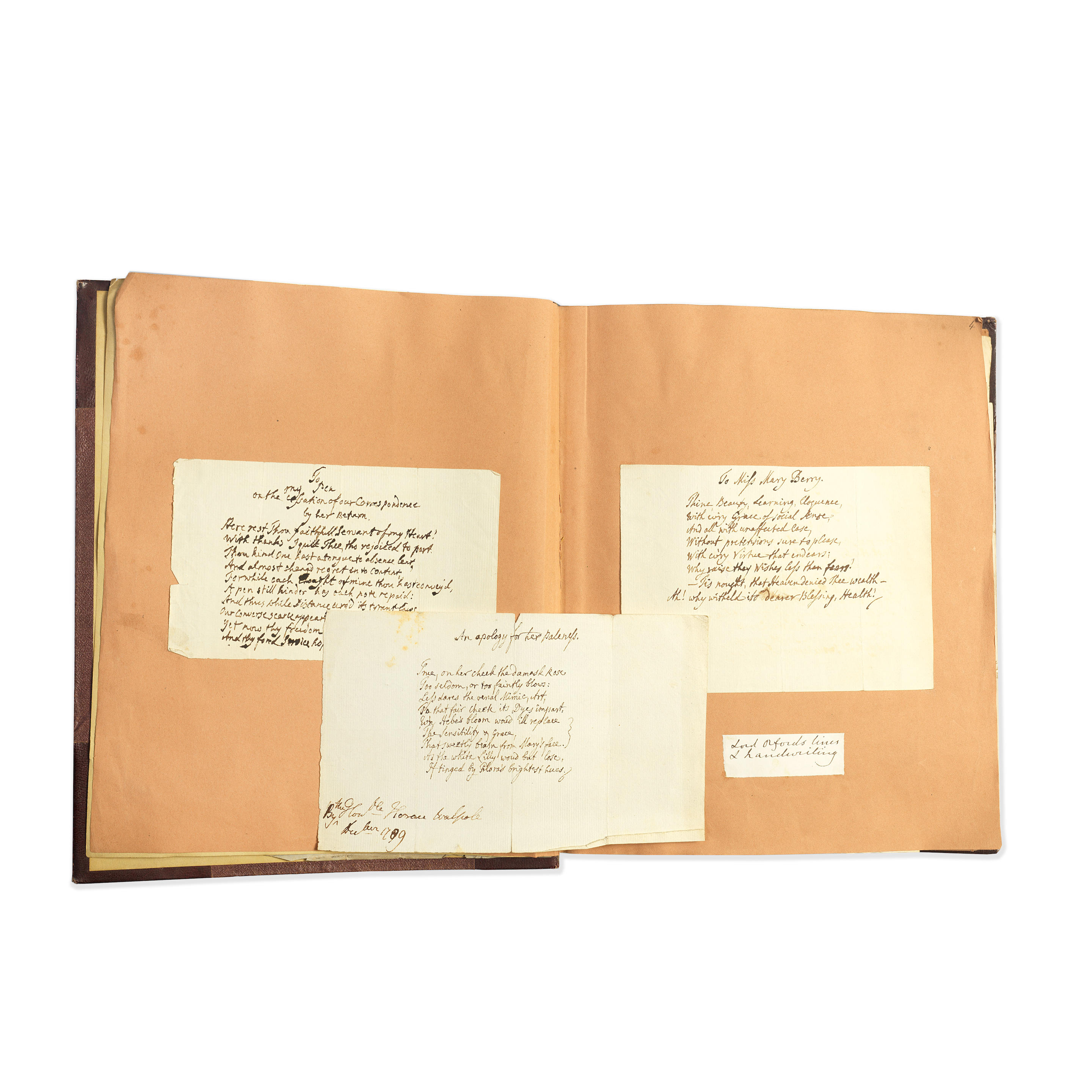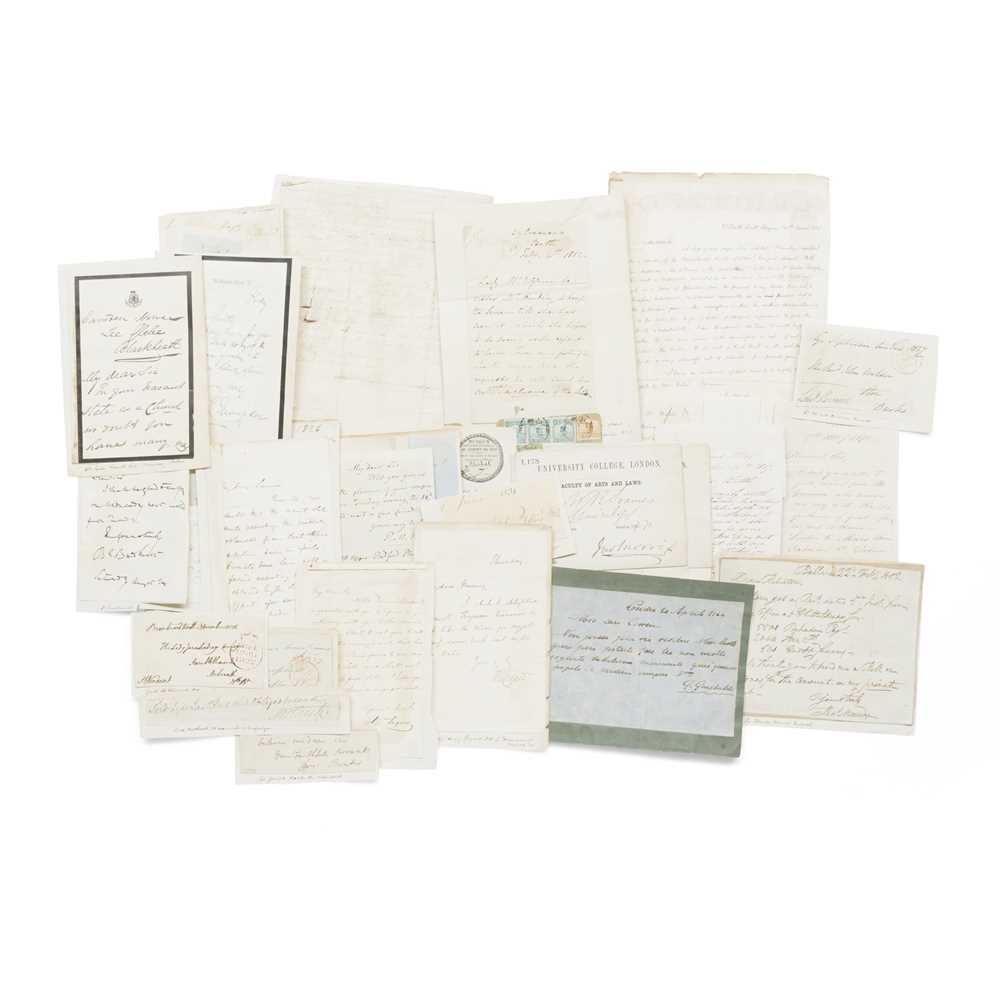Lot of 12. Including: Thaddeus Sobieski Constantine Lowe (1832-1913; Civil War aeronaut, scientist, inventor). Lowe has been called the father of military aerial reconnaissance. Lowe set up demonstrations for Lincoln of aerial reconnaissance and messaging. After his performance at the first Battle of Bull Run, Lincoln had him establish a balloon Corps and train the men to operate them. It was always a civilian contract, thus if they were captured, they could not be tried as spies and potentially executed. Calling card with "Compliments of Prof. & Mrs. T.S.C. Lowe." Sir Charles Wheatstone (1802-1875; English scientist/inventor). Most of his contributions were in electrical developments and telegraphy and ciphers. He also developed a stereoscope and concertina. Signed slip of paper (3 x 4.75 in.) William Williams Keen, Jr. (1837-1932; surgeon). Keen is credited with being the first American brain surgeon. He worked with six Presidents, including FDR when his paralytic illness struck. TLS, 2pp, Nov. 10, 1921. Gustaf Lindstrom (1829-1901; paleontologist). Lindstrom was a Swedish paleontologist who later in his career worked at the Swedish Museum of Natural History in Stockholm. ALS, 2pp, May 25, 1878. Robert Ogden Doremus (1824-1906; chemist and physician). Doremus was one of the founders of the New York Medical College (1850) and one of the first in America to require medical students to study (and pass) chemistry. Signed sheet from bound volume signed "R. Ogden Doremus, August 17th, 1887" with page number 29 upper right. Verso with "Whitneymockridge, May 25th, '85." Whitney Mockridge was famous in the late 19th century as a tenor, appearing all over the nation with orchestras and opera companies. Rene Just ("Abbe") Haüy (1743-1822; French mineralogist). Often considered the "Father of Modern Crystallography." Known as "Abbe" after being made an honorary canon of Notre Dame. Clipped signature. David Starr Jordan (1851-1931; ichthyologist, eugenicist, educator). Jordan was President of Indiana University (1884-1891) and the first President of Stanford University (1891-1913). Signed calling card with date Dec. 11, 1907. Bradley Allen Fiske (2) (1854-1942; naval officer and technical innovator). Fiske worked his way through the ranks, becoming a Rear Admiral in 1911. He developed over 130 devices, most initially for military use, but many also had civilian uses. He won the Elliot Cresson Medal of the Franklin Institute in 1891 for invention of the rangefinder. Signature on top half of Waldorf-Astoria letterhead, and also on the bottom of the same sheet. Top stamped with "Sep 20 1926." Henry Darwin Rogers (1808-1866; geologist). Rogers' father was an admirer of a poem by Eramus Darwin (Charles' grandfather) and so gave his son his middle name in honor of the poet/naturalist. Among other studies, he did surveys of New Jersey and Pennsylvania. He and his brother, William, who surveyed Virginia, published an account of the formation of the Appalachian Mountains and its coal deposits. Signed calling card. Mary Elizabeth Lyell (1808-1873; geologist/paleontologist, wife of Sir Charles Lyell). Mary was the daughter of geologist Leonard Horner. Fluent in French and German, she translated scientific papers for her husband. Later, she specialized in conchology. ANS, 4pp on 3.5 x 5.25 in. note paper with address at the top. Mary Lyell was one of those strong women who bucked the male-dominated scientific fields and managed to achieve some level of recognition for their own research (even though they could not join scientific societies or give papers at meetings). Paul Erman (1764-1851; German physicist). Most of his work was in electricity and magnetism, with a few findings in optics and physiology. Signed holograph quote titled "Atmosphaerologia." Alexis Boyer (1757-1833; French surgeon). Boyer became Napoleon's family surgeon, and conferred on him the Legion of Honor and title of Baron with a salary of 25,000 francs in 1808 (or so). ALS, in F
Lot of 12. Including: Thaddeus Sobieski Constantine Lowe (1832-1913; Civil War aeronaut, scientist, inventor). Lowe has been called the father of military aerial reconnaissance. Lowe set up demonstrations for Lincoln of aerial reconnaissance and messaging. After his performance at the first Battle of Bull Run, Lincoln had him establish a balloon Corps and train the men to operate them. It was always a civilian contract, thus if they were captured, they could not be tried as spies and potentially executed. Calling card with "Compliments of Prof. & Mrs. T.S.C. Lowe." Sir Charles Wheatstone (1802-1875; English scientist/inventor). Most of his contributions were in electrical developments and telegraphy and ciphers. He also developed a stereoscope and concertina. Signed slip of paper (3 x 4.75 in.) William Williams Keen, Jr. (1837-1932; surgeon). Keen is credited with being the first American brain surgeon. He worked with six Presidents, including FDR when his paralytic illness struck. TLS, 2pp, Nov. 10, 1921. Gustaf Lindstrom (1829-1901; paleontologist). Lindstrom was a Swedish paleontologist who later in his career worked at the Swedish Museum of Natural History in Stockholm. ALS, 2pp, May 25, 1878. Robert Ogden Doremus (1824-1906; chemist and physician). Doremus was one of the founders of the New York Medical College (1850) and one of the first in America to require medical students to study (and pass) chemistry. Signed sheet from bound volume signed "R. Ogden Doremus, August 17th, 1887" with page number 29 upper right. Verso with "Whitneymockridge, May 25th, '85." Whitney Mockridge was famous in the late 19th century as a tenor, appearing all over the nation with orchestras and opera companies. Rene Just ("Abbe") Haüy (1743-1822; French mineralogist). Often considered the "Father of Modern Crystallography." Known as "Abbe" after being made an honorary canon of Notre Dame. Clipped signature. David Starr Jordan (1851-1931; ichthyologist, eugenicist, educator). Jordan was President of Indiana University (1884-1891) and the first President of Stanford University (1891-1913). Signed calling card with date Dec. 11, 1907. Bradley Allen Fiske (2) (1854-1942; naval officer and technical innovator). Fiske worked his way through the ranks, becoming a Rear Admiral in 1911. He developed over 130 devices, most initially for military use, but many also had civilian uses. He won the Elliot Cresson Medal of the Franklin Institute in 1891 for invention of the rangefinder. Signature on top half of Waldorf-Astoria letterhead, and also on the bottom of the same sheet. Top stamped with "Sep 20 1926." Henry Darwin Rogers (1808-1866; geologist). Rogers' father was an admirer of a poem by Eramus Darwin (Charles' grandfather) and so gave his son his middle name in honor of the poet/naturalist. Among other studies, he did surveys of New Jersey and Pennsylvania. He and his brother, William, who surveyed Virginia, published an account of the formation of the Appalachian Mountains and its coal deposits. Signed calling card. Mary Elizabeth Lyell (1808-1873; geologist/paleontologist, wife of Sir Charles Lyell). Mary was the daughter of geologist Leonard Horner. Fluent in French and German, she translated scientific papers for her husband. Later, she specialized in conchology. ANS, 4pp on 3.5 x 5.25 in. note paper with address at the top. Mary Lyell was one of those strong women who bucked the male-dominated scientific fields and managed to achieve some level of recognition for their own research (even though they could not join scientific societies or give papers at meetings). Paul Erman (1764-1851; German physicist). Most of his work was in electricity and magnetism, with a few findings in optics and physiology. Signed holograph quote titled "Atmosphaerologia." Alexis Boyer (1757-1833; French surgeon). Boyer became Napoleon's family surgeon, and conferred on him the Legion of Honor and title of Baron with a salary of 25,000 francs in 1808 (or so). ALS, in F















Testen Sie LotSearch und seine Premium-Features 7 Tage - ohne Kosten!
Lassen Sie sich automatisch über neue Objekte in kommenden Auktionen benachrichtigen.
Suchauftrag anlegen